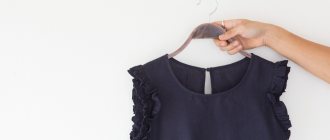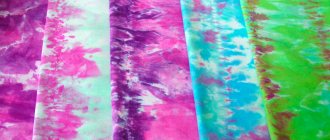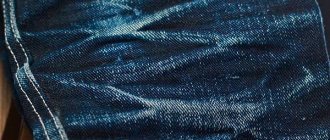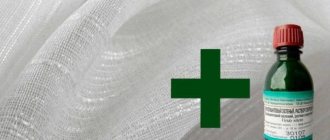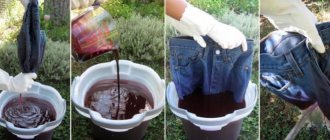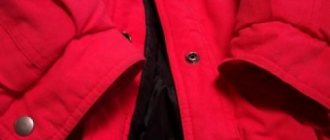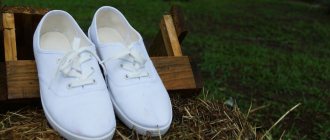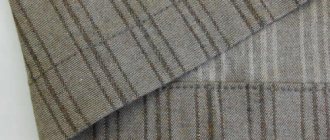Preparing for painting
Before you start work, you need to prepare everything you need, namely:
- things intended for dyeing;
- container and devices for turning fabric;
- dyes and rinses.
How to properly prepare clothes for dyeing
Before painting, you will have to remove the fittings from the clothing.
- First of all, you should wash your clothes thoroughly. If there are old stains on the fabric from grease, oil or other difficult-to-remove substances, you should definitely get rid of them. Otherwise, the fabric in this place will be dyed unevenly, and clearly visible stains will remain, which will greatly spoil the appearance of the product.
- Then you will have to remove the accessories - cut off buttons and decorations, flog metal zippers, since the surface of these parts can be damaged when painted and subsequently become covered with rust.
- If you decide to dye a new product made of cotton or linen, you need to remove the layer of starch that the manufacturer usually impregnates such fabrics with. To do this, prepare a soap solution, add a little soda and boil the clothes for 25 minutes, after which they rinse thoroughly.
- When dyeing wool yarn, you need to make sure that the threads do not intertwine or get tangled. To do this, it is divided into small parts and collected into loose skeins, which are tied in two or three places with twine.
Selecting containers and equipment for coloring
Once the clothes are prepared for dyeing, you can begin choosing a container.
- Any clean utensil will do, be it an enamel basin or an aluminum pan. The main thing is that there are no traces of scale or soot on the inner surface of the metal.
- Particular attention should be paid to the size of the container. The pan should be of such a volume that the thing to be painted is located freely in the solution, does not squash and does not rise above the surface of the water.
To stir and turn the product while working, you will need wooden tongs. If you don’t have such a device on your farm, you can use ordinary wooden sticks, after first clearing the surface of knots and uneven surfaces.
It is better to take soft water for the procedure, for example, rain or melt water. If this is not possible, then ordinary tap water can be softened with baking soda, for which 1 tbsp. l. powder is dissolved in 10 liters of water.
How to paint a product yourself
The choice of paint depends on the composition of the fabric and the preferences of the owner of the clothing.
Textile paint is available in the following forms:
- aerosol,
- pastes,
- powder.
It is suitable for use when dyeing by hand or in a washing machine. The choice of dye depends on the composition of the fabric and the personal preferences of the owner of the clothing.
Before starting work, it is necessary to accurately determine the composition of the product. If the label is erased or lost and it is not possible to find out reliable information about the composition, you can set fire to the thread from the product. Synthetic and natural fibers release different “flavors” when burned:
- synthetics smell like chemicals;
- natural wool or cotton emits the smell of burnt hair.
The easiest way to repaint a thing is from natural materials. Synthetics are difficult to paint and quickly lose their newly acquired shade.
The general rules for using universal fabric paint are the same regardless of the manufacturer of the product. However, when starting coloring, it would be useful to study the instructions included with the product in order to know exactly the dosage and nuances of using a particular dye.
Important! All work with the dye must be carried out with rubber gloves.
If the dye does not require heating the water, then it is better to carry out the work in the bathroom, having previously protected easily soiled items with waterproof film. Then the following activities are carried out:
- Pour paint into a container with warm water and stir thoroughly. The amount of water and dye is determined in advance depending on the weight of the clothing and the dosage indicated by the manufacturer on the packaging.
- The product is dipped into the solution and left for half an hour, stirring occasionally and making sure that the fabric does not wrinkle.
- As soon as the product acquires an intense black color, it can be removed from the solution and rinsed in cool water, adding 1 tbsp. l. vinegar.
Important! If you need to paint several things, you need to paint them one by one.
Often the instructions require heating the coloring solution, then proceed as follows:
- The container with paint dissolved in water is placed on low heat and heated to a temperature of 60 °C.
Important! When dyeing wool and silk, add 50 ml of 25% vinegar essence to the solution.
- The item prepared for painting is immersed in a hot solution for an hour, maintaining a constant temperature of no more than 60 ° C and stirring occasionally.
- After the allotted time has passed, the product is washed in a machine or by hand at a water temperature of 40 ° C and rinsed with the addition of vinegar.
In the future, you should wash and rinse items painted black separately from the rest of your clothes, and add vinegar to each rinse.
Natural dyes for fabric are one of the components of health and purity of life
05.08.2019
We are accustomed to an abundance of fabrics of various colors and shades and often do not even think about how one or another was obtained - we simply choose the one we like. More recently, our ancestors used plants as dyes, those that grew within reach. It is both environmentally friendly and filled with living energy. And this work was painstaking, manual. And now fabrics are dyed with chemical dyes in large factories by machine. Then microscopic chemical components, through the clothes we wear, through the linen we sleep on, enter our body, first on its surface, and then inside... Imperceptibly depriving us of health and strength.
Now that sanity takes precedence over the thirst for cheapness, variety and having as many things as possible, we are increasingly inclined to use only natural substances for all household purposes. And herbal dyes are great helpers for us in this.
The ancient art of dyeing fabrics using natural methods is being revived these days. And if at the same time we use herbs grown with a caring hand in our own garden, then the clothes we wear are filled with greater meaning and protective power.
Richness of natural dyes
The possibilities of the plant kingdom are great. What exactly did the Russians use for dyeing? How did you paint it and what colors did you get?
Plants that accumulate dyes – pigments – in various organs (roots, stems, leaves, flowers, wood, bark) and tissues are considered to be dyeable. Some crops were previously used on an industrial scale, specially grown for this purpose.
In modern conditions, for the needs of one family, only 3-10 plants are enough, which can be successfully integrated into a country flower garden or created from them as a hedge.
Yellow and brown
Having decided to get solar coloring, our ancestors could use more than two dozen plants. Some of them were used entirely: immortelle, heather, cuff, navel, string. And in the genus of gorse, shrubs and subshrubs of the legume family, there is even a species that is called just that - dyeing. For the same purpose, flowers and leaves of goldenrod (also called golden rod), jumper (also having a second name - impatience), and sickle grass were used. Only flowers were taken if it was about the umbrella hawkweed and, oddly enough, the meadow cornflower, and also the horned frog. By the way, the leaves of birch and black grass (or verbolosis) were used.
The zealous owners also did not forget about the root system of plants: sorrel and iris turned out to be useful here (it received a very affectionate nickname - iris). And the bark was taken from hazel and wild apple trees for dyeing purposes.
Sometimes certain plant parts were chosen based on the material to be dyed. Thus, the leaves and stems of the moss moss (aka the ram), as well as the flowers of the rapeseed, were taken into account when working with wool, and the swimsuit was used only for canvas.
Yellow dyes
Voskovnik
, a low shrub with large leaves, common in the north of Russia, has several varieties known as wax berry, wax heather, etc.; the fruits have a waxy layer. Waxberry has a lot of coloring matter, giving it a bright yellow color. As experts note, the dye from this plant is very resistant to fading.
Bearberry
- bear grapes, similar in appearance to lingonberries, the berries are mealy, grows in sandy areas and in pine forests, must be collected after the berries appear. Gives a yellow color.
Buckthorn
— wolf berries, the coloring matter is in the bark. It grows throughout Russia and has many local names: buckthorn, medzhina, prickly buckthorn, laxative, okoster, proskurina, etc. The bark of some types of buckthorn gives a yellow color when fresh, and brown when dry.
Angular cornflower
- leaves dye silk and wool.
Basilisk
- Leaves dye wool.
centaury
- grass dyes wool.
Monoberry
- paints the canvas.
Sagebrush
- the grass colors straw and fawn, with alum - lemon color.
Bedstraw
- flowers with the addition of alum are painted dark yellow.
Barberry
- bush. The dye is obtained from bark, roots and wood.
Zheltinnik
- in Ukraine called skompia, the coloring substance in the leaves and young branches, collected in August, dried, crushed and ground.
Brown dyes
Lichens, torchovka, oak foot
- grow almost everywhere, on the ground and stones. Lichen growing on stones produces a particularly durable brown color.
Black alder
- common in temperate Russia, coloring matter in leaves, young branches and bark.
Dry buckthorn bark
- gives a brown color.
Plum tree bark
- gives a brown color.
Serpukha grass
— dyes linen and silk fabrics.
Horse sorrel
- its root, dug up in the fall, gives a brown color.
Orange and red
To make the canvas “red,” there were significantly fewer folk methods. This could be provided by black alder bark. And in order to achieve the desired result with the help of celandine, alum was added to it.
In the red range there were more possibilities and, mainly, the roots of plants were used as dyes, in particular, cinquefoil (also called cinquefoil and silver), buckwheat (i.e. crayfish necks), soft bedstraw (this is a cosmos grass) true bedstraw (we are talking about rennet - yellow porridge). If the material was wool, then they used the roots of St. John's wort. But there was also a ground part of the grass, thanks to which the tissues “turned red”: this is white pigweed, or, more simply, quinoa.
Blue, blue and green
The blueness of the canvas was given with the help of ash bark, and if it was necessary to dye wool, cornflower or buckwheat flowers. Bird buckwheat (popularly called ant grass) is capable of turning the material blue, and the whole plant is used, like woad. This same woad was used as a dye for woolen materials and was highly valued in the handicraft carpet production.
Blueberries were used to dye flax blue and wool blue.
By the way, the just mentioned woad-krutik was also used to obtain green color. However, along with other plants.
Blue dyes
Moss lycopodium
- herbaceous plant; coloring matter in the stem of a plant.
Vaida
(sinilo, chenille, farbovnik) - grows in temperate Russia, the coloring matter is contained in the leaves.
Buckwheat
- growing wild on the shores of the Caspian Sea. The coloring matter in the leaves is deep blue (indigo).
Forest geranium
- coloring matter in flowers.
Blackberry
- the berries are painted dark blue.
Blueberry
- the berries dye wool soaked in alum (1:10) purple.
Litmus test
— grows in Crimea. The grass dyes the wool purple, known by the French as Tournesol.
Meadow sage
- The grass turns dark blue.
Green dyes
Elder
- they do not use ripe berries, as for red paint, but elderberry leaves, which give a good green color.
Swamp horsetail, ironweed, squirrel tail
- grows everywhere; The coloring matter in the stem gives the green color.
Sorrel
- grows almost everywhere; coloring matter in leaves.
Juniper
- grows almost everywhere; coloring matter in berries.
Rue and blue iris flower
- the juice from them, mixed together, gives a strong green color.
Privet
- The berries color the fur dark green.
Bird cherry
- The inner bark turns green.
Poplar
- the inner bark dyes the yarn green, the yarn must be pre-moistened with iron sulfate (1:10).
Black
In order to achieve the black tone of the material, several plants were used. These include berries and roots of voronets (funnel), meadowsweet bark, leaves and stems of podbel, bearberry leaves (in other words, bear's ears) and the juice of a herb with the amusing name of brilliant zyuzik. It has a number of popular names: water horehound, wolf's foot (or paw), wild queen plant, forest hemp, marsh nettle, speckled grass, heart grass, chistets).
A decoction of onion peels, juices of beets, carrots, and green crops (parsley, dill) are used as food colorings; juice of chokeberries, blueberries. It is interesting that not only higher plants, but also mushrooms are used as dyes.
In your herb garden, you can create a herb-dye corner. They can be grown among other crops or placed separately.
General rules for collecting and preparing dye plants
- for harvesting flowers and inflorescences - during the period from budding to the end of flowering;
- for harvesting roots and rhizomes - dig up late autumn or early spring;
- to harvest grass or above-ground parts, the plants are cut with a sector (or a small sickle) fresh, not withered: in the evening - before the dew appears, in the morning - after it disappears;
- harvest only in dry weather or after the plants have dried from the rain;
- The collection of raw materials is carried out (according to the part of the plant to be harvested): flowers - almost blossomed, but not wilted; leaves and stems - mainly before flowers bloom; fruits - at the moment of maturity; roots - in spring or autumn;
- the collected plants are laid as loosely as possible or hung;
- When using freshly squeezed juice, it is made immediately after harvesting the raw materials.
Stages of vegetable dyeing of fabric
The collected plants must be chopped, filled with water and boiled.
After boiling the solution, it is best to leave it to cool overnight along with the plants, so they will infuse and give up all their coloring matter. The next day, you need to remove all parts of the plants from the water. Now the aqueous solution of the dye must be evaporated for a more intense color and filtered.
The fabric must be washed and dried before dyeing.
Cook the fabric after boiling point for an hour. Then cool in the solution without removing the fabric; the longer you leave it, the more dyed it will become. After this, cool the solution and rinse the fabric in running water several times. Add 2 tbsp to the last rinse. l. table vinegar or essence 1 tbsp. l. The vinegar will set the dye.
Dry the fabric and enjoy the result.
Important rules for dyeing fabric using natural means
Before we begin the process of dyeing fabrics and clothes, let's understand the nuances.
- Clothes, threads or fabric must be perfectly clean.
- Before dyeing, things need to be boiled in plain, clean water softened with soda ash. For silk fabrics, in the penultimate rinse, use ammonia 0.5 g per 1 liter of water.
- Use only enamel (without chips) or glass (fireproof) dishes. The stirring stick should be made of wood or durable plastic.
- Sometimes the fabric needs to be kept in an alum solution to better fix the dye on the fiber. This process is called mordant. For mordant, in addition to various alums, copper or zinc sulfate, and natural home remedies are used - sauerkraut juice, vinegar. You can use formic acid, ash from birch firewood. Prepare a mordant at the rate of 1-10g per liter of water. For every 100 g of fabric or yarn you will need at least 3 liters of mordant solution. The fabric is boiled in the mordant for 5 to 30 minutes, after which it is removed without wrung out and placed in the dye. You don’t have to boil it, but simply soak the fabric in the mordant. The mordant can be used not only before dyeing the fabric, but also after. The final shade of color will depend on your experiments.
- The speed of fabric dyeing depends on the temperature of the water, various additives in the dye solution and, of course, on the fabric itself.
- Dying wool gives better results than cotton or linen. When dyeing wool, the water should be boiling. And at the end of dyeing, vinegar is added to the solution.
- Silk threads or fabric are also boiled in a dye solution for up to an hour, just like wool.
- On the contrary, the dyeing of cotton, viscose and linen products in hot water slows down, i.e. the whole process will take more time. Therefore, make sure that the water temperature does not exceed 85 degrees. Then the dyeing process will take 45-60 minutes. At the end of coloring such things, you need to add table salt (2-3 tablespoons).
- The dye solution in relation to the weight of the fabric (yarn) should be 20 times greater, i.e. things must be in free “floating” in order to be painted well.
- Vinegar and salt will set the dye and the fabric will fade less. When rinsing items made from any fabric for the last time, always add a little vinegar.
- Painted items must be hung (or laid out) correctly immediately to dry. Otherwise, stains and smudges may form on the fabric.
The most important thing: before dyeing the entire fabric, experiment on a small piece of fabric, going through all the technological processes.
The home dyeing room should be well ventilated.
Please consider any allergies to plants that you decide to use as a dye. Some plants can be poisonous. Use gloves to avoid burns or bright paint stains.
As you can see, dyeing fabric at home is not an easy task. Here you need to be extremely careful in the selection of dyes, fixatives and spend a lot of time to get the desired result.
Dyeing fabric, like painting pictures, is all in the hands of the artist. Mixing paints, holding time, and different treatments of fabric before dyeing give completely different results when using the same components.
In conclusion, I would also like to give a list of herbal dyes from the article by V.P. Levasheva “Procurement and use of auxiliary production materials”, published in the collection of the series “Proceedings of the State Historical Museum” “Essays on the history of a Russian village of the X-XIII centuries,” M. , 1959 pp.94-104
Plant name – Dye source – Dye color:
- White pigweed (quinoa). Chenopodium album L. – Grass – Red.
- Sabelnik (cinquefoil, silver). Covarum plustre L. – Root – Red.
- Buckwheat (crayfish necks). Poligonum bistorta L. – Root – Red. Dubitel.
- Wild galangal (Uzik, Potentilla). Potentilla erecta Hampe. - Root. Root + rusty iron.
- Root + alum – Blue. Dubitel. Black/Blue.
- St. John's wort. Hypericum quadrangulum L. – Roots – Red (for wool).
- St. John's wort. Hypericum perforatum. – Flowers and leaves – Red and yellow.
- Soft bedstraw (woodgrass, cosma grass). Galium mollugo L. – Roots – Red.
- True bedstraw (yellow porridge, rennet). Galium verum L. – Roots – Red.
- Swimsuit. Trollins europaeus L. – Flowers – Yellow (for canvas).
- Surepitsa. Barbarea vulgaris L. – Flowers – Yellow (for wool).
- Immortelle tsmin. Helichrysum arenarium DC. – The whole plant is yellow.
- Chamomile. Anthemis tinctoria L. – Whole plant – Yellow.
- Dying gorse. Genista tinctoria L. – Whole plant – Yellow.
- Serpukha. Serratula tinctoria L. – Grass – Yellow.
- Umbrella hawkweed. Hieracium umballatim L. – Flowers – Yellow.
- Meadow cornflower. Centaurea jacea L. – Flowers – Yellow.
- Cuff. Alchimilla vulgaris L. – Whole plant – Yellow. Dubitel.
- Sorrel. Rumel acetosa L. – Roots – Yellow. Dubitel.
- A series. Bidens tripartius. – The whole plant is yellow.
- Iris (iris). Iris pseudacorus L. – Root – Yellow. Dubitel.
- Goldenrod (golden rod). Splidago virga auren L. – Flowers and leaves – Yellow.
- Horned frog. Genista tinctora L. – Flowers – Yellow.
- Jumper (touchy). Impatiens noli tagare L. – Flowers and leaves – Yellow.
- Wild apple tree. Pyrus malus. – Bark – Yellow.
- Birch. Betula verrucosa. – Leaves – Yellow.
- Chernotal (verbolosis). Salix pentandra L. – Leaves – Yellow.
- Heather. Calluna vulgaris salisb. – The whole plant is yellow. Dubitel.
- Hazel, hazel. Corylus avellani L. – Bark – Yellow. Dubitel.
- Celandine. Chelidonium majus L. – Whole plant + alum – Orange.
- Moss (ram). Lycopodium selago L. – Stems, leaves – Yellow (for wool).
- Double-edged clubmoss (greenback, dog). Lycopodium complanatum L. – Whole plant – Green/Yellow/Red.
- Moss club-shaped. Lycopodium clavalum L. – Leaves – Green.
- Stinging nettle. Urtica dioica L. – Stem, leaves – Green.
- Watch, trefoil. Menyates trifoliata L. – Stem, leaves – Green.
- Tansy (wild mountain ash). Tancetum vulgaris L. – Roots – Green.
- Aspen. Populus tremula L. – Cones + shankweed – Green.
- Apple tree (wild and domestic). Pyrus malus, Malus domestica – Flowers and leaves. Bark + alum – Green/Red.
- Oak. Quercus robur L. – Bark/Bark+rusty iron – Dark blue. Dubitel/Black
- Ash. Fraxinus excelcior L. – Bark – Blue. Dubitel.
- Cornflower. Centaurea cyanus L. – Flowers – Blue (for wool).
- Bird buckwheat (ant grass). Poligonum aviculare L. – Whole plant – Blue. Dubitel
- Blueberry. Vaccinium myrtillus L. – Berries – Light blue (linen)/Dark blue (wool).
- Buckwheat (blue bells). Gentiana pneumonathe L. – Flowers – Blue (wool).
- Vaida (krutik). Isatis tinctoria L. – Whole plant – Blue.
- Blackberry. Rubus caesins L. – Berries – Purple/Crimson.
- White alder. Corylus avellani L. – Bark + rusty iron / Bark + spruce cones – Brown / Yellow to black.
- Black alder. Alnus glutinosa gaerth. – Cora – Red. Dubitel.
- Gray willow. Salix cinerea L. – Bark – Brown (reddish to chocolate). Dubitel
- Alder buckthorn. Frangula alnus Mill. – Bark, leaves, berries / Dry bark – Yellow / Brown
- Voronets. Alkana spicata L. – Berries – Black.
- Meadowsweet. Filipendulla ulmaria Maxim. – Bark – Black. Dubitel.
- Zyuzik. Lycopus europaeus L. – Grass juice – Black.
- Bearberry (bear ears, bear berry). Arctostaphylos uva ursi Spr. – Leaves – Black.
- Underbel. Andromeda polifolia L. – Leaves and stem – Black. Dubitel.
- Onion. – Onion peel – Yellow/Brown
© Methodical
Other articles on the topic "Sanity"
If you want to always learn about new publications on the site in a timely manner, then subscribe to our newsletter.
Dyeing in the washing machine
For dyeing, the washing machine is set to a washing mode in which the cycle duration does not exceed 30 minutes.
You can use a washing machine to dye clothes. Modern dyes have compositions that are completely safe for the operation of household appliances, and the process itself is easier and faster than manually.
- Pour 0.5 liters of hot water into the container and pour out one package of dye. Mix thoroughly, trying to dissolve all grains of powder and obtain a homogeneous mixture.
- Things are turned inside out and loaded into the washing machine. When dyeing, do not use washing powder or conditioner.
- A dye is poured into the machine. You can simply tear the paint bags and put them on top of your clothes.
- When dyeing silk or other delicate fabrics, add 150 ml of 25% vinegar essence.
- Set the washing mode in which the water temperature does not rise above 60 ° C and the cycle duration is no more than 30 minutes, including rinsing.
- After dyeing is completed, wash again at a temperature of 40 ° C, which will allow the paint to adhere well.
The products are dried by laying them out on a horizontal surface away from radiators and avoiding direct sunlight.
To completely clean the machine drum of traces of dye, you need to carry out one cycle in the “rinse” mode using chlorine bleach.
Natural dyes
In addition to aniline and acrylic dyes, there are natural dyes, which are ordinary products. You can dye the product black using coffee, tobacco or hair dye:
- Coffee will help restore the intense black color of fabric that has lost its original appearance. To dye, you need to prepare enough instant or boiled coffee so that the liquid can cover the item being dyed. The stronger the drink, the brighter the color of the fabric. The coffee is brought to a boil, removed from the heat, and the item prepared for painting is immersed in a pan for an hour. The longer the fabric is in the solution, the more colored the fibers will be.
- Instead of coffee, you can take tobacco. To prepare a dyeing solution, pour 15 g of tobacco into 1 liter of water and boil it, after which the product intended for painting is immersed in the container.
How to dye white bed linen with beets at home
Another one of the best natural textile dyes is beetroot, with which you can get purple and bluish shades.
Indeed, the procedure for dyeing linen with beets is the same as with coffee.
You just need to prepare water, salt, vinegar, red beets and the linens you want to dye. Remember that it is important that the bedding is made of cotton.
How to dye white bed linen with beets at home:
- bring water to a boil, add chopped beets;
- let simmer for several hours;
- remove from heat and strain the liquid, discarding the beets;
- add the liquid to the basin and soak the cloth, making sure it is well covered;
- let the dye sit for several hours, depending on what shade you want to get;
- add vinegar and salt, 3 tablespoons per liter, and stir with a wooden stick or spoon until the whole cloth is saturated and coated;
- leave for 2 hours;
- drain the water and air dry the laundry;
- iron the linen to set the color.
Useful tips
For those people who don't often dye items from their wardrobe, the helpful tips and tricks listed below can come in handy.
- If you have to paint a product for the first time, it is better to practice on an old unnecessary thing that you don’t mind throwing away if it fails.
- To accurately determine the required amount of dye, the textiles must be weighed.
- If the item to be repainted is intended to be remade, then it should be torn into pieces in advance.
- Uneven coloring of synthetic fabric can be corrected by immersing the product in a hot soapy solution.
- Items dyed black should be washed separately from other clothes. The fact is that they can fade and ruin all the other things in the drum.
Dyeing your favorite clothes black, done at home, will not only return the items to a bright, rich color, but will also save time and money. The main thing is to buy paint from trusted manufacturers, follow the instructions and listen to the advice of experienced housewives.
Other natural dyes for dyeing bedding in different colors at home
In addition to the natural laundry dyeing products we've reviewed, we encourage you to try others to get a variety of colors.
Here are some ideas for using natural dyes to dye bedding in different colors:
- to get red and pink shades, you must use natural products such as red wine, flowers in these shades such as roses, red tulips and poppies, and red fruits such as cherries, lingonberries and strawberries;
- the green color will be obtained if you use decoctions and juices from green leaves such as spinach or parsley;
- You can paint your bed linen purple with black blackberries;
- yellow, orange and brown shades can be obtained by dyeing linen with onion skins, saffron or chamomile.
After dyeing your laundry using natural products, do not wash it with bleaching or aggressive chemical powders. Use natural soap-based CHISTOWN powders for washing.
In this article, we looked at how to dye white bed linen a different color using natural means at home.
